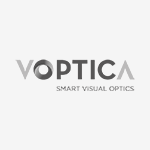Purpose: Although there are many multifocal intraocular lenses (IOL´s) available, patient’s expectations concerning good near vision are not always reached. The clinical use of instruments based on adaptive optics (AO) simulation would help in selecting the optimum IOL for each patient. We evaluated the efficacy of a unique system to simulate different profiles of multifocal IOL´s.
Methods: A commercially available clinical AO based visual simulator (AOnEye, Voptica, Spain), was used. The instrument incorporates an aberrometer, a liquid crystal modulator to induce the profiles and a microdisplay to present the visual stimuli. It was used to evaluate four different IOL’s profiles; two diffractive (bifocal and trifocal) and two that induce depth of focus (DOF) by adding spherical aberration (SA) (mild/strong: sphere (S) +0.75/+1.30; SA 0.1/0.4 microns for 4.5 mm pupil). Through focus decimal visual acuity (VA) was measured at infinity, 100, 66.6, 50, and 33.3 cm in 22 patients (12 young dilated and 10 presbyopic undilated patients).
Results: The results agreed with theoretical simulations. The bifocal lens showed significant better VA at infinity 0.88 ± 0.22 (mean ± SD) and near 0.78 ± 0.16. The trifocal showed no significant difference between the distances with a mean VA of 0.74 ± 0.16. The mild DOF design showed a good VA for intermediate 0.90 ± 0.18 but showed a decreased performance at far and near (0.69 ± 0.09 and 0.59 ± 0.20 respectively). For the strong DOF VA improvement with decreasing distance (minimum: 0.43 ± 0.14 at far; maximum: 0.86 ± 0.19 at near). Intersubject preference was detected.
Conclusions: A clinical adaptive optics visual simulator was proved to be functional to predict clinical visual outcomes of different presbyopic lens profiles. This instrument provides patients the option to show a subjective preference permitting customization/selection of the optimal IOL.
Methods: A commercially available clinical AO based visual simulator (AOnEye, Voptica, Spain), was used. The instrument incorporates an aberrometer, a liquid crystal modulator to induce the profiles and a microdisplay to present the visual stimuli. It was used to evaluate four different IOL’s profiles; two diffractive (bifocal and trifocal) and two that induce depth of focus (DOF) by adding spherical aberration (SA) (mild/strong: sphere (S) +0.75/+1.30; SA 0.1/0.4 microns for 4.5 mm pupil). Through focus decimal visual acuity (VA) was measured at infinity, 100, 66.6, 50, and 33.3 cm in 22 patients (12 young dilated and 10 presbyopic undilated patients).
Results: The results agreed with theoretical simulations. The bifocal lens showed significant better VA at infinity 0.88 ± 0.22 (mean ± SD) and near 0.78 ± 0.16. The trifocal showed no significant difference between the distances with a mean VA of 0.74 ± 0.16. The mild DOF design showed a good VA for intermediate 0.90 ± 0.18 but showed a decreased performance at far and near (0.69 ± 0.09 and 0.59 ± 0.20 respectively). For the strong DOF VA improvement with decreasing distance (minimum: 0.43 ± 0.14 at far; maximum: 0.86 ± 0.19 at near). Intersubject preference was detected.
Conclusions: A clinical adaptive optics visual simulator was proved to be functional to predict clinical visual outcomes of different presbyopic lens profiles. This instrument provides patients the option to show a subjective preference permitting customization/selection of the optimal IOL.


